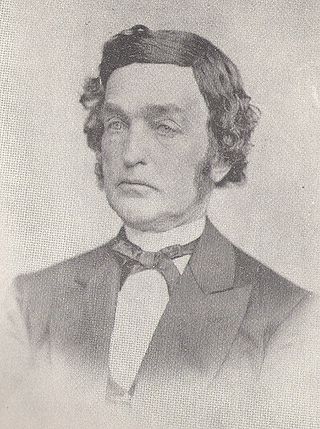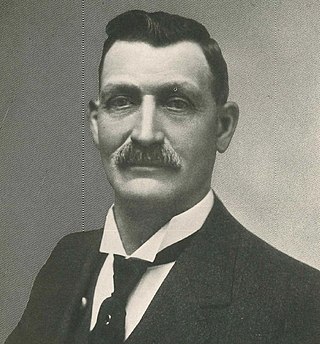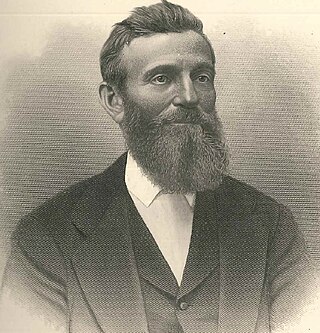
Ludington is the largest city and county seat of Mason County in the U.S. state of Michigan. As of the 2010 census, the city population was 8,076.
The Flint and Pere Marquette Railroad (F&PM) is a defunct railroad which operated in the U.S. state of Michigan between 1857 and 1899. It was one of the three companies which merged to become the Pere Marquette Railway.

Aaron Burr Caswell (1807–1896) was an American frontiersman and the first white man to occupy any part of Mason County, Michigan. He became the county's first coroner, probate judge and surveyor; and constructed its first framed building that functioned as a home, courthouse and jail—it is also the only surviving landmark of Mason County's earliest history. Caswell was also the progenitor of a prominent Mason County family.

James Ludington was an American businessman. He obtained a sawmill in the village of Pere Marquette. Ludington platted the land there and formed a town with a lumber company operation. He sold his interest to the lumber company for a large sum of money and became wealthy. The town later changed its name and became Ludington, Michigan, although he never lived there.

Charles Mears was a Michigan lumber businessman, capitalist, merchant, transportation executive, engineer, and farmer. He owned thousands of acres of timber in Michigan, and had 15 sawmills to produce lumber. Mears built cargo boats to transport his lumber to Chicago, and developed several harbors in western Michigan.

Eber Brock Ward was an American industrialist, iron and steel manufacturer, and shipbuilder. He was known as the "steamship king of the Great Lakes" and the "first of the iron kings." Ward became Detroit's first millionaire. His steel factories made him, in his time, the wealthiest man in the Midwest.

Antoine Ephrem Cartier was a 19th-century American businessman who assisted in the development of Ludington, Michigan. He was a business owner, stock speculator, lumber tycoon, sawmill owner, and real estate investor. He was mayor of Ludington from 1880 through 1888 and progenitor of a line of mayors sharing his Cartier name.

Warren Antoine Cartier was a 19th-century northern Michigan businessman who helped establish Ludington, Michigan. He was twice elected mayor of the city and was the owner of several businesses, a banker, a lumber tycoon, a sawmill owner/operator, and a real estate investor. In civic life, he was involved with many societies and organizations.

Justus Smith Stearns was an American lumber baron and businessman. He was involved in many enterprises that involved commercial real estate development, sawmills, coal mining and sales, farming, railroading, and electrical technology. He started his lumber pursuits as a teenager at his father's sawmills. This expereience and business knowledge. learned from his father, led to his becoming a lumber merchant in his twenties.
The Mason and Oceana Railroad (M&O) was a short common carrier, 3 ft narrow gauge logging railroad in the U.S. state of Michigan. Organized in 1887 and in operation from 1887 until 1909, it served the counties of Mason and Oceana in the northwestern quarter of Michigan's Lower Peninsula in the late 19th and early 20th centuries.

The SS Pere Marquette was the world's first steel train ferry. It sailed on Lake Michigan and provided a service between the ports of Ludington, Michigan, and Manitowoc, Wisconsin, for the Pere Marquette Railway from 1897 to 1930. The railway used the name Pere Marquette for many of its ships and ferries, adding a number to the end of the name.

William L. Mercereau was an American design engineer and business manager of train ferries for the Pere Marquette Railway. He supervised their railroad-over-water system of steel train ferries which operated from Ludington, Michigan which was the largest carferry system in the world.

Robert Logan was a Scottish naval architect. He was a university graduate of mathematics, science, and engineering. Logan designed and constructed several large ships for various shipbuilding firms worldwide. His first ones were passenger cruise excursion boats and later constructed freighter ships for the American Shipbuilding Company that carried railroad trains across Lake Michigan. He designed the world's first steel train ferry, followed by several more Logan boats that ultimately developed into the world's largest carferry fleet that operated out of Ludington, Michigan.

The SS John Sherman, originally the USRC Sherman or USRC John Sherman was built for the United States Revenue Cutter Service in 1865 before being disposed of by the United States Government in 1872. It was a United States sidewheeler ship initially used as a Revenue Cutter on the Great Lakes of North America before being used for ferry service across Lake Michigan between the states of Michigan and Wisconsin. In 1874 the ship was chartered by Flint and Pere Marquette Railroad to become the first ship used by the company transporting freight and passengers.

William Albert L. Rath was a German expatriate living in the United States. He was known for developing and shaping Ludington, a harbor town on Lake Michigan that was part of Mason County, Michigan. Rath was a timber baron and a business magnate who became wealthy. He was mayor of Ludington for one term and a member of the town's board of trade and board of aldermen as well as the county's board of supervisors. He is memorialized in Ludington by a street, a building, and a mural.

Edward Augustus Foster was a nineteenth century businessman and lumber tycoon known for helping to develop various lumber businesses.

Luther Hall Foster was a nineteenth century businessman and lumber tycoon known for helping to develop various lumber businesses.

John Mason Loomis was a nineteenth-century American businessman and lumber tycoon from Chicago who was known for developing the city of Ludington, Michigan. He was involved with the Pere Marquette Lumber Company, which also operated salt distilleries that in turn influenced the salt industry of northern Michigan. The village of Pere Marquette benefited from these local industries and developed into the city Ludington.

Delos L. Filer was a businessman involved in developing Manistee County and the towns of Manistee, Filer City and Ludington in the state of Michigan. He owned sawmills and related businesses.

SS Pere Marquette 18 was a steel-hulled Great Lakes train ferry that served on Lake Michigan from her construction in 1902 to her sinking in 1910.




















